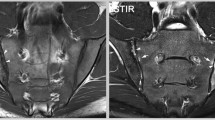Abstract.
Posttraumatic osteomyelitis is frequently characterized by chronicity and recurrent activation of infection. The diagnosis is usually made on the basis of clinical, laboratory, and imaging examinations. The conventional radiograph is the basic imaging study that provides important information about skeletal deformity, bone quality, identification of metallic implants, and consolidation of the former fracture site. Other imaging techniques are required to determine the grade of activity, to define the extent of infection and to delineate small sequestra, intraosseus fistula and abscesses. A variety of more sophisticated modalities, such as modern cross-sectional imaging and radionuclide studies, are available, and the decision to choose the most suitable method can be very difficult. This review gives an overview of definition, epidemiology, and pathophysiology of chronic posttraumatic osteomyelitis and discusses the value of currently used imaging modalities.
Similar content being viewed by others
Author information
Authors and Affiliations
Additional information
Electronic Publication
Rights and permissions
About this article
Cite this article
Kaim, A.H., Gross, T. & von Schulthess, G.K. Imaging of chronic posttraumatic osteomyelitis. Eur Radiol 12, 1193–1202 (2002). https://doi.org/10.1007/s00330-001-1141-0
Received:
Revised:
Accepted:
Published:
Issue Date:
DOI: https://doi.org/10.1007/s00330-001-1141-0




